How Are Diamonds Made? Natural vs Lab-Created Explained
Two Paths, One Diamond Not all diamonds come from the same place — but they all start the same way. Pure carbon, crystalized under immense pressure and heat. Whether it…
If you take one thing away from us, make it what’s on this page.
15 minutes spent on the information below could be the most important in all of your diamond research. Consider a bookmark. Unlike color and clarity, where high grades are strict and rare, more than 60% of round brilliants receive the “Excellent” cut grade, despite having visible quality differences.
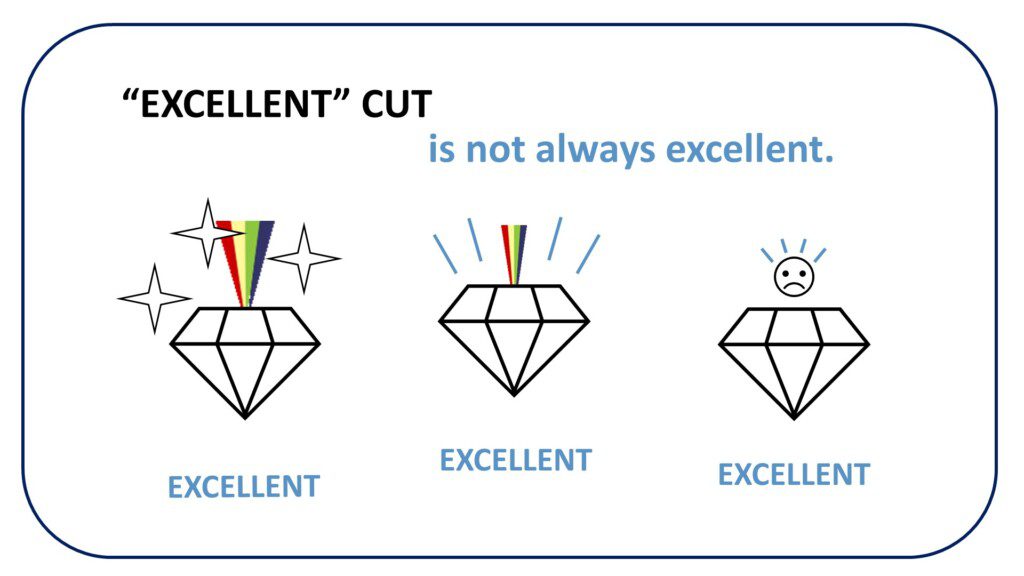
PriceScope Pointer: Take a cut quality shortcut. See our Descriptive Proportions Chart to know whether a round diamond shows more brightness, more fire, or a balance of both. Our longstanding Member Recommended Proportions are listed there too.
Before going on: Check out the PriceScope Diamond Buying Guide
PriceScope Diamond Subsets
Intermediate Diamond Cut
Advanced Diamond Cut
Diamond cut assesses craftsmanship and basic light behavior (for round diamonds). However, unlike the other Cs, laboratories disagree on how cut should be graded.

Unlike color and clarity, where the highest grades are rare, the majority of round brilliant diamonds receive the GIA’s top cut grade of “Excellent,” despite having visible differences in character and quality. Additionally, unlike color and clarity terms, the term “ideal cut” is widely abused, and has many different meanings and definitions, depending on the seller. Also unlike the other Cs, which are largely standardized, a diamond graded “Excellent” by one laboratory could be judged “Very Good” by another and “Fair” by still another. Most labs issue no cut grade for fancy shapes.
All diamond shapes are graded for polish, which analyzes how lustrous and unblemished the surface is – and symmetry, which judges the evenness and consistency of a diamond’s surface outline and facets.
Round Brilliant diamonds also receive an overall diamond cut grade – a conclusion by that laboratory about how bright or dark the diamond is. Diamonds cut with geometries too deep or too shallow may appear dark for various reasons, while diamonds with proportionate geometries successfully reflect, refract and return light to the viewer as brightness, fire, sparkle, and contrast.
Be advised: Most diamonds are cut with deep angles, because it brings more profit to diamond producers.
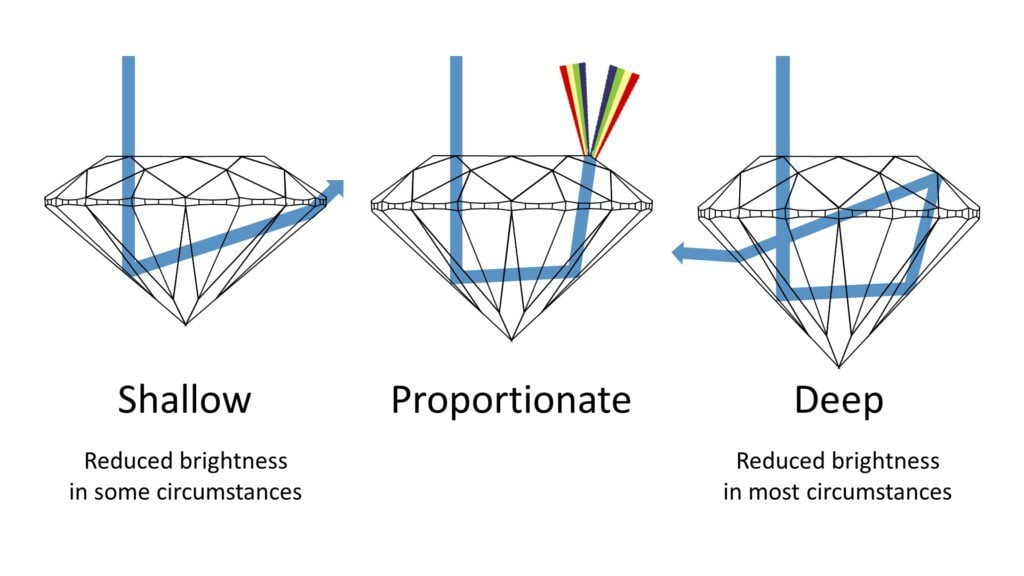
Find proportionate diamonds with proven brightness now: The elite brands offered by our vetted vendors like Whiteflash A CUT ABOVE®, Astor by Blue Nile™ and JamesAllen.com True Hearts™ are collections of diamonds with superior cut quality.
Warning: You can dive deeper and deeper into this topic – and that’s okay. You should at least break the surface and learn the limitations of grading reports. Beyond that, how far you choose to “nerd out” (and we mean that as a compliment) is up to you.
Shortcut: Use Our HCA To Hit The Cut Quality Bullseye
Not everyone needs to become a diamond cut rocket scientist, but if you want to be fully confident about the high quality of diamonds you’re considering, the methods below have been proven – again and again.
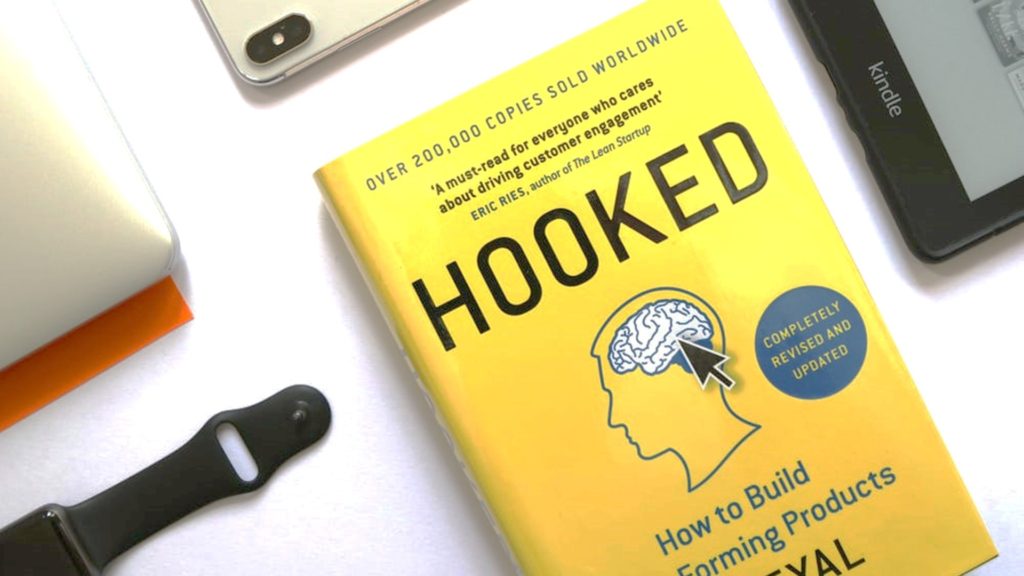
Choose The Path That’s Right For YOU
If you want to stay dry, just click back to the PriceScope Diamond Buying Guide and follow the shortcuts. But if you want to dive in and learn more about judging cut quality in one sitting than most diamond buyers will ever know, just keep reading. You might even become the person your friends all turn-to for diamond advice.
We’re not kidding.
The inconvenient truth is that most diamonds are not cut well because carat weight has the most influence on price. That motivates diamond producers to keep the most possible weight in the diamond when cutting.
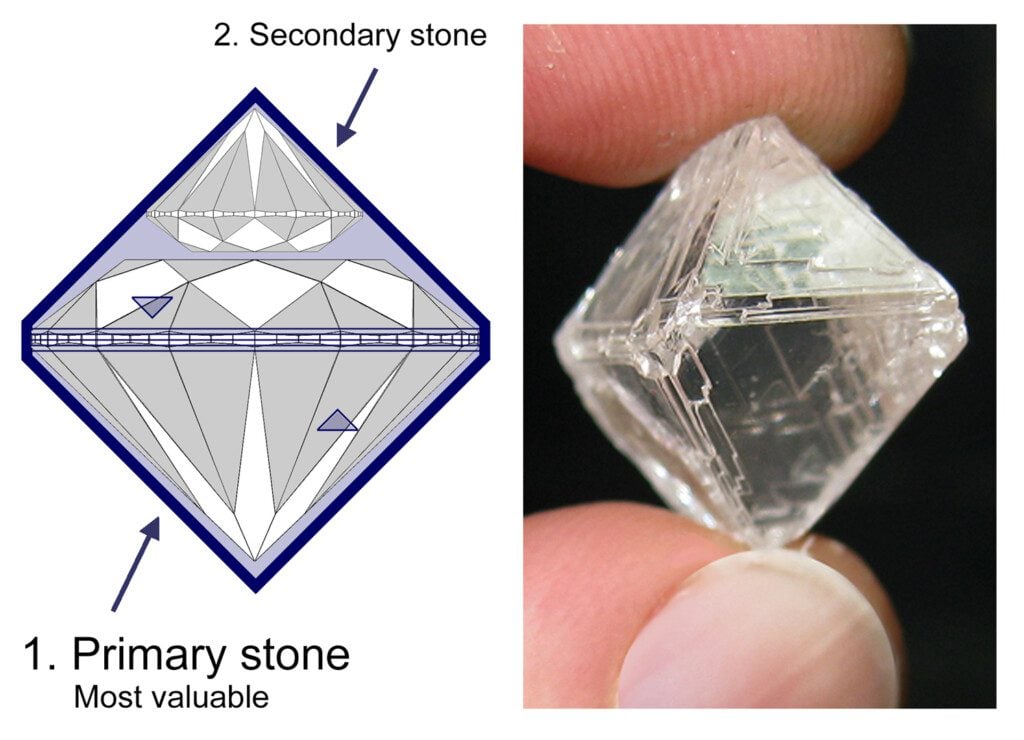
The typical rough diamond octahedron produces two finished diamonds. The primary stone has the most value. Diamond producers profit most by using angles as close to the rough outline as possible (circa 45 degrees) which can still earn a favorable grade like “Excellent” or “Ideal.” However, those angles often aren’t the best for brightness, resulting in darker, less lively diamonds.
Yes. Most diamonds are produced for the weight over beauty. This is possible because most laboratories maintain very loose diamond cut grading standards. As stated above, more than 60% of round diamonds passing through GIA receive their top cut grade of Excellent, despite being produced for weight over beauty (see statistics here). It’s not an exaggeration to say most diamond shoppers have probably never seen a diamond that was cut to have the best possible brightness and sparkle.
Bottom Line: Cut has the most influence on diamond beauty but is the least emphasized in many places, and the majority of diamonds are produced for weight over beauty.
PriceScope Pointer: For shapes other than round you’ll need different evaluation methods than those described below.
YES. You may be happy to learn PriceScope is considered a real pain-in-the-neck by many diamond sellers.

This is because our community specializes in diamond cut assessment knowledge. We have more diamond enthusiasts with more experience in a wider range of diamond beauty than any other online resource. With a community made of members who are consumers like you, you can be sure they have your best interests in mind.
![]()
The PriceScope community will help you predict the visual qualities of diamonds you are considering. Experienced members can identify discernible subsets or “makes” of round brilliant diamonds, three of which are described below (other subsets exist but are less frequent – we plan to detail them on a separate page).
| “Steep Deep” | “PriceScope Ideal” | “Super Ideal” |
The three examples below are hypothetically polished from the same starting rough crystal (the dark blue outline). As you can see they have different final weights.
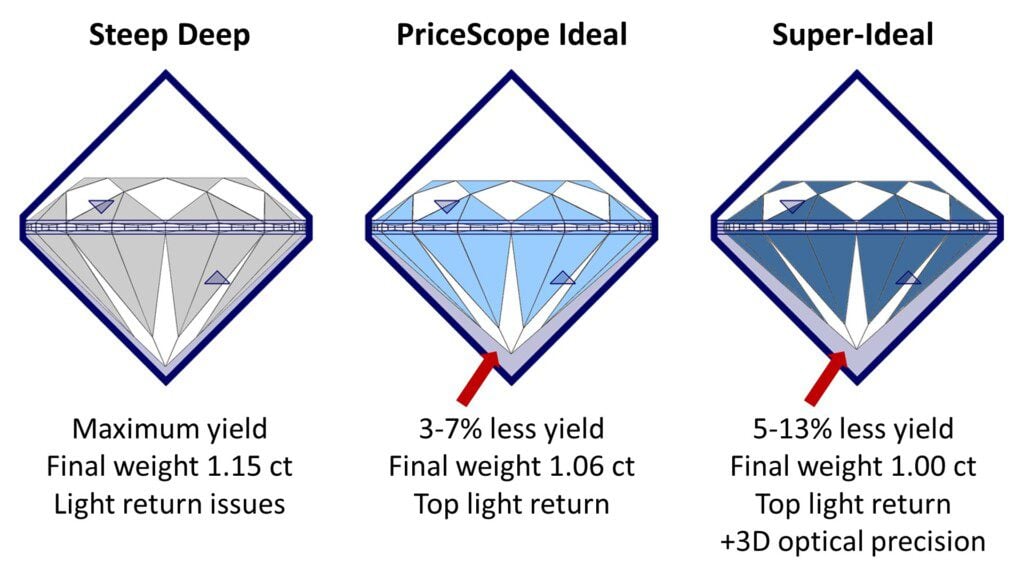
The different final weights result from different cutting goals. Remember, the more cut attention a diamond is given, the more weight is polished away, and the smaller the finished diamond becomes.
In the world of round brilliant diamonds this subset is most abundant, by far. Producers use wide (steep deep) cutting angles to increase the diamond’s final weight, maximizing yield. Those wide angles cause some of the light entering the diamond to leak out of the bottom, instead of reflecting and returning to the viewer’s eyes. When removed from bright lights, steep deep diamonds quickly go dark and look physically smaller than they should.
Since they finish heavier than other subsets, steep deep diamonds are frequently less expensive for the relative carat weight. Using the illustrations above, this steep deep finished at 1.15 carats, notably heavier than the other two subsets would finish if polished from the same rough diamond crystal.
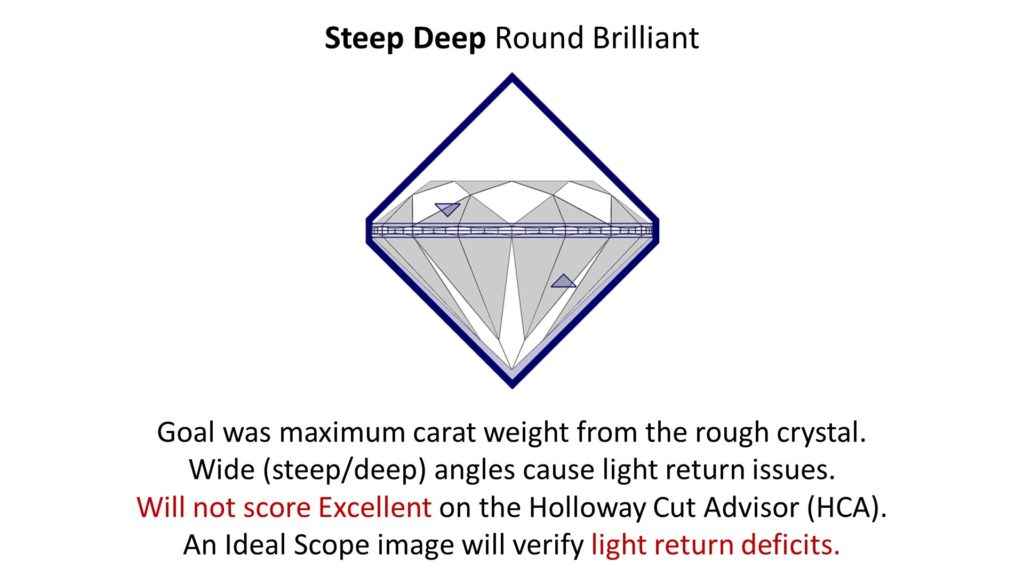
A PriceScope Ideal is cut with proportionate angles which successfully reflect and return light back to the viewer’s eyes as brightness, fire, contrast, and sparkle. Some specimens emphasize brightness over fire, or vice-versa, depending on specifics, but all have robust light return. A PriceScope Ideal scores Excellent on the Holloway Cut Advisor: When removed from bright lights it will remain brilliant and lively. Only 20% of round brilliant diamonds graded ‘Excellent’ or ‘Ideal’ meet our definition of PriceScope Ideal (PriceScope estimate).
Diamonds like this finish smaller than steep deep makes, making their performance proposition more expensive for the relative carat weight. Using the illustrations above, the PriceScope Ideal finished at 1.06 carats, notably lighter than the steep deep would finish, if polished from the same rough diamond crystal.
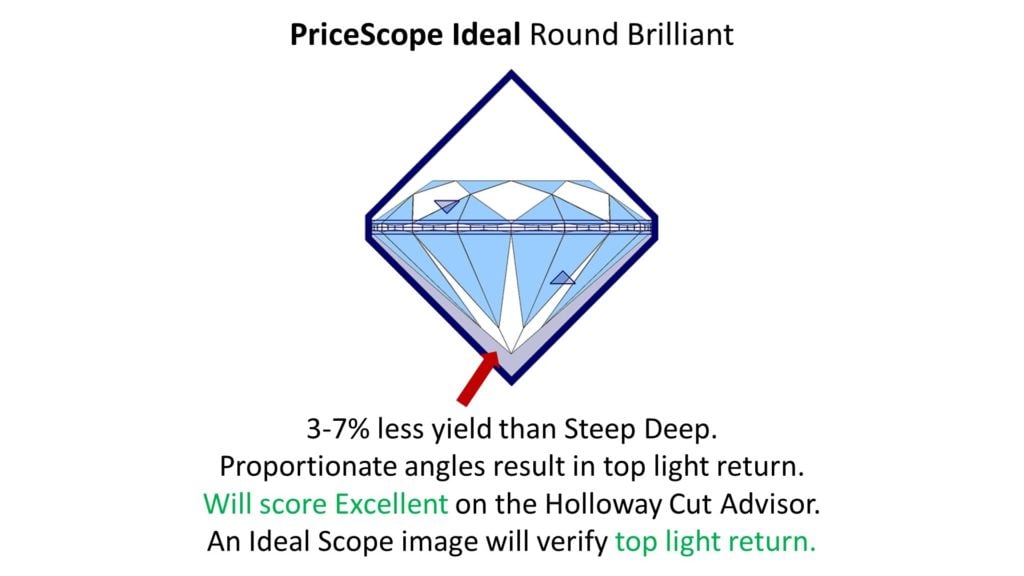
PriceScope Ideal, equivalent version: The description above has successfully served thousands of diamond shoppers on PriceScope, but taste varies. Some of our members prefer different visual character. Some prefer a different shape entirely. In that spirit, a PriceScope Ideal may be defined as any aesthetically pleasing diamond you see and personally love.
Only 3-5% of round brilliant diamonds graded ‘Excellent’ or ‘Ideal’ fall into the Super Ideal subset (PriceScope estimate), making them extremely rare. They are cut within a small range of scientifically proven “ideal” proportions which promote balanced brightness, fire, sparkle, and contrast. Beyond those basic proportions, their internal reflections are further fine-tuned to display 3D optical precision (aka Hearts & Arrows), proven in a specialized viewer.
The best Super Ideal diamonds are not casually or accidentally made. The narrow range of angles and fine tuning cause them to finish much smaller than steep deep diamonds, making their performance proposition decidedly more expensive for the relative carat weight. Using the illustrations above, the Super Ideal finished at 1.00 carat, which is significantly lighter than the 1.15 carat steep deep would have finished, if polished from the same rough diamond crystal.
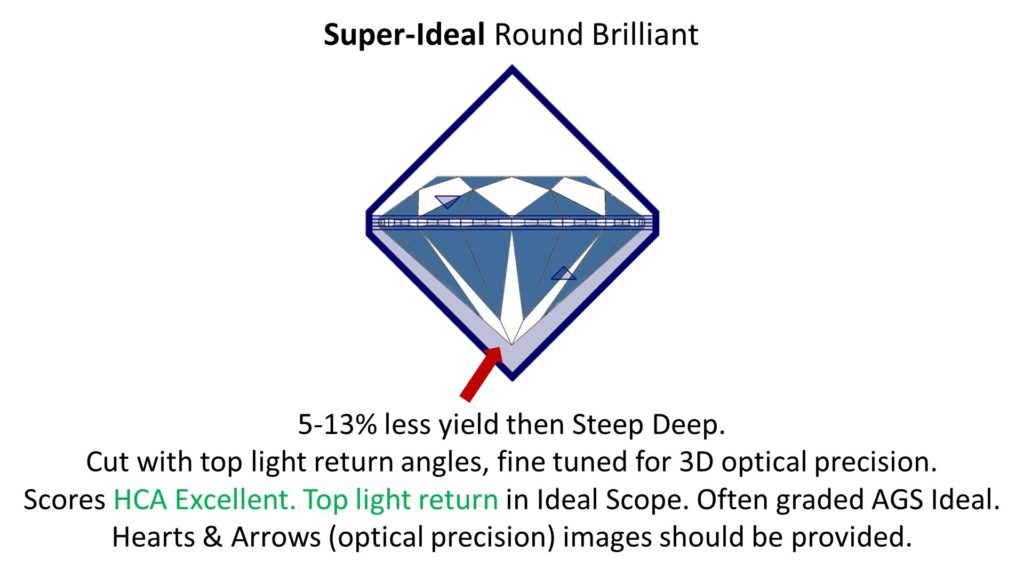
To identify Super Ideal diamonds graded by laboratories other than AGS, use the Holloway Cut Advisor (HCA) first, then ask for an Ideal Scope image to verify top light return. For any diamond sold as “Super Ideal,” actual Hearts & Arrows images should be provided.
See Super Ideal diamonds for yourself: Some of our vetted vendors offer collections of diamonds accompanied by AGS Ideal light performance reports and hearts and arrows images. Check out JamesAllen.com True Hearts™ Hearts & Arrows diamonds and Whiteflash A CUT ABOVE® super-ideal diamonds.
Does improved diamond performance come with a pricing premium? Or is there actually a discount for average cutting?
Remember these three examples have the same raw material cost. All three have the same color and clarity. All three earned the “Excellent” cut grade. On paper the only difference is carat-weight.

According to market cost (Feb 2021) check out these examples if they had H color, VS1 clarity and were all priced with the same retail markup:
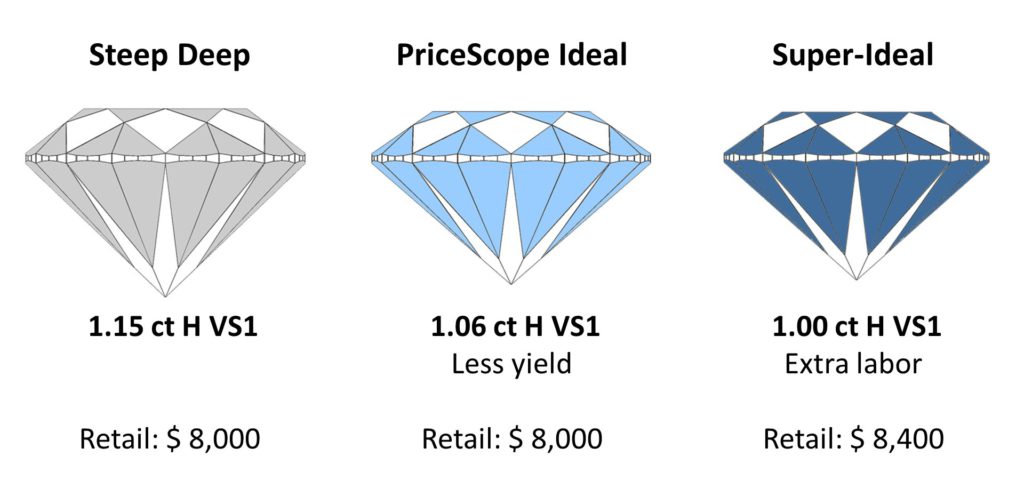
To a casual shopper, the 1.06 and 1.00 probably appear to command “premiums” over the 1.15, but that’s not quite true. Remember, the 1.00 and 1.06 could also have finished at 1.15, but the cutter chose to keep polishing to improve brightness and optical quality. There was no premium added, instead more weight was removed to improve appearance. In that sense, instead of a premium for positive polishing, there is a discount for leaving it deep.
Steep deep diamonds are most abundant on the market because, lacking this education, casual shoppers assume they are getting more carat weight for the money. Many jewelry stores do not carry diamonds in the PriceScope Ideal or Super Ideal subset, so you may never have seen one in person before.
Successful online sellers like our recommended PriceScope vendors, have methods of reliably classifying and communicating the quality of a diamond’s cut, whether you’re examining it in-person or purchasing online. They additionally offer liberal inspection periods and free returns, to ensure that you’re delighted with your purchase.

PriceScope Pointer: Take a cut quality shortcut. See our Descriptive Proportions Chart to know whether a round diamond shows more brightness, more fire, or a balance of both. Our longstanding Member Recommended Proportions are listed there too.
Just Imagine:
If, instead of diamond looks and performance, we are trying to predict the looks and performance of an athlete:
Note: Before going on, learn to identify brightness, leakage, contrast, fire, and other performance components on our illustrated page Diamond Performance Explained.
See our Descriptive Proportions Chart and Member Recommended Proportions.
The physics of light-behavior within a diamond are reliably consistent, which means proportions measurements can be used to draw certain conclusions about the quality of a diamond’s cut and its likely appearance. There are eight facet groups on a round diamond: See Round Brilliant Diamond In Detail for a look at all of them.
You only need four primary proportions to take the next step and use the patented online Holloway Cut Advisor (HCA).
| Table % | Depth % | Crown Angle | Pavilion Angle |
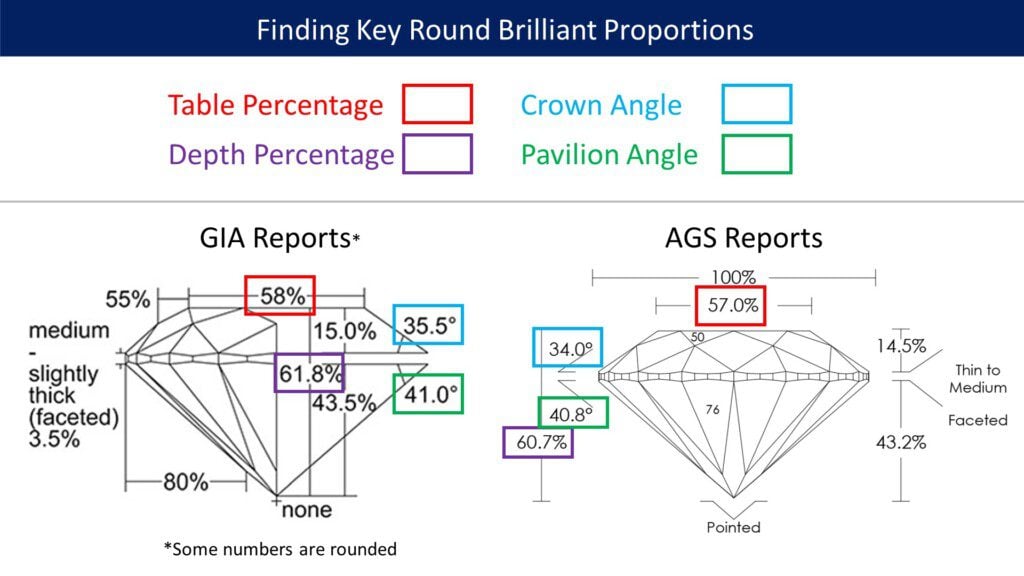
With those four data points, along with the diamond’s carat weight and millimeter measurements, you are ready to use the HCA.
Two of those numbers are averages of eight measurements, and there is no way to know how far the minimum and maximum measurements are “off” from that average.
With the exception of reports issued by the American Gem Society Laboratories (AGS) and primary measurements given by the International Gemological Institute (IGI), nearly all given proportions data on grading reports has been averaged and additionally rounded.
| Major Proportions | AGS-IGI report to: | GIA-GCAL report to: | Average of: |
| Table Facet | 0.1% | nearest 1% | 1 measurement |
| Crown Angle | 0.1 degree | nearest 0.5 | 8 measurements |
| Pavilion Angle | 0.1 degree | nearest 0.2 | 8 measurements |
| Girdle Thickness | Description | GIA 0.5%, GCAL 0.1% | variable |
| Culet | Description | Description | 1 measurement |
| Minor Proportions | AGS reports to: | Others report to: | Average of: |
| Star Length | 1% | nearest 5% (IGI NR) | 8 measurements |
| Lower Half Length | 1% | nearest 5% (IGI NR) | 16 measurements |
| Upper Half Length | Not reported | Not reported | 16 measurements |
| Calculations | AGS reports to: | Others report to: | Average of: |
| Total Depth % | 0.1% | 0.1% | Not averaged |
| Crown Height % | 0.1% | nearest 0.5% | Not averaged |
| Pavilion Depth % | 0.1% | nearest 0.5% | Not averaged |
Proportions are terrific to use with broad predictive analysis tools. If you want to get into nuances like diamond cut consistency or 3D optical precision, we cover them below in performance scope images and computer modeling.
PriceScope Pointer: The numbers on GIA reports are not accurate to a tenth of a degree, like those on AGS reports. The Pavilion Angle is rounded to the nearest 0.2 degrees. The Crown Angle, Star, and Lower Halves are rounded to the nearest 0.5 degrees or 5%. This prevents extremely detailed cut analysis of GIA-graded diamonds.
The Holloway Cut Advisor (HCA) is an analytic tool that uses measurements of a round brilliant diamond to calculate the potential light return, fire, scintillation, and spread. When you register with PriceScope you can analyze three diamonds for free. HCA scores are also included in PriceScope round diamond search results.
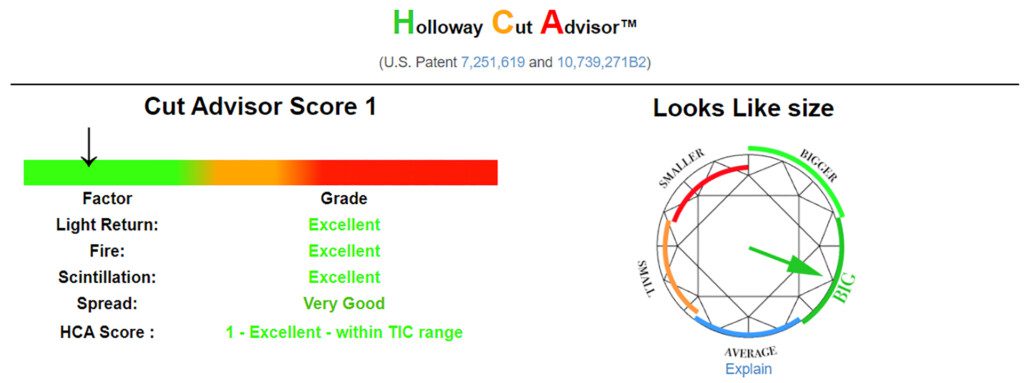
The HCA is the best rejection tool available for assessing diamond cut. Its primary use is disqualifying proportions sets known to “leak light” and reduce brightness. While doing this it also gives reliable broad predictions about light return (brightness) and spread (physical size for carat weight), as well as hypothetical but logical conclusions about predicted fire and scintillation.
The HCA score is not diamond specific. It does not take the 40 minor facets into consideration (of 57/58 on the diamond). It does not account for nuances of cut consistency or 3D optical precision, for those seeking such detailed diamond cut analysis.
The HCA is the best overall prediction tool available. It simply but reliably predicts diamond brightness based on key data points. A comparison would be an “HCA radar gun:” Such a tool would reliably tell you, from a distance, what cars have unsafe drivers so you can reject going for a ride. It also identifies perfectly safe drivers, but is not capable of deducing which of those might be the “safest” driver.
PriceScope lists over 500,000 diamonds from the world’s top vendors in the only search engine which features the Holloway Cut Advisor as one of it’s filters.
Did you know? You can use the Holloway Cut Advisor to perform analysis on any round diamond listed by our vetted vendors, including the hundreds of thousands listed by JamesAllen.com and Blue Nile.
Online sellers focused on high quality diamond cut are increasingly adopting Ideal Scope and the AGS ASET (angular spectrum evaluation theory) scope. These are two reliable methods of proving or disproving that a diamond is properly returning the light it gathers from above to the viewers’ eyes.
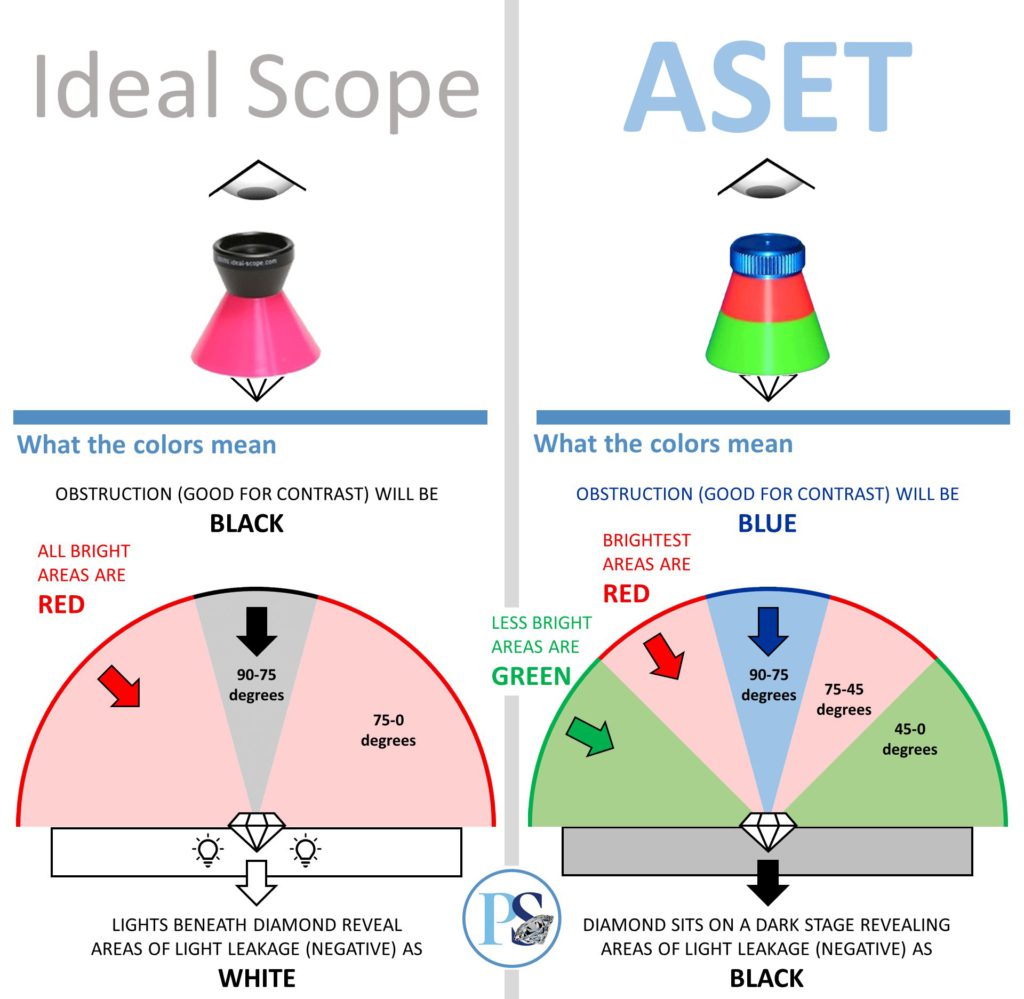
Superior: Diamonds cut with the best light return will show edge-to-edge red in both viewers. They will have symmetrical, evenly distributed contrast patterns seen as black (Ideal Scope) or blue (ASET). The only areas of leakage will be tiny symmetrical points of white at facet meet points and the girdle.
Average: Diamonds cut with average light return may have negative white/gray areas of leakage (windowing) near the center and/or at the girdle. They may show light drawn from disadvantageous low-angles (green) in ASET. Their contrast patterns, seen as black (Ideal Scope) or blue (ASET), may not be symmetrical or evenly distributed.
Poor: Diamonds cut with poor light return will have distinctive areas of negative white/grey leakage near the center, possibly showing as circular “rings” of leakage. They often show light drawn from disadvantageous low-angles (green) in ASET, particularly along the girdle/edge of the diamond. Their contrast patterns, seen as black (Ideal Scope) or blue (ASET), may only resolve partially and are asymmetric.
PriceScope Pointer: Some jewelers don’t know the difference between performance scopes (which show light return behavior) and Hearts and Arrows viewers (which show optical precision but not performance). Be sure your chosen jeweler understands the difference.
Structured lighting environments such as Ideal Scope and ASET are the simplest but most effective way to “map” the light traveling through a diamond. Brightness, leakage, and contrast can be meaningfully assessed, especially in standardized setups.
Performance scopes images provide a motionless view of brightness, leakage, and contrast, but the benefits of diamond cut performance occur in motion, over a full range of tilt. Different setups may also influence how much or little leakage is seen.
When buying a diamond online Performance Scope Images are a tremendous help in understanding the overall quality of a diamond’s light behavior as it relates to critical components of brightness, leakage, and contrast.
Did you know? A number of our vetted vendors, including Whiteflash and JamesAllen.com provide ideal-scope images, so you can be confident that the diamond you purchase is well cut.
Think of a diamond as a tiny geometric sculpture where every facet has a purpose. The light behavior, particularly how bright or dark that diamond will be, depends on the alignment and orientation of all facets in relation to each other.
Computer modeling diamond cut begins with a 3D scan created in a diamond scanning device. In this process the diamond is placed upside-down on a rotary platform, surrounded by lights. The lights turn on and the silhouette of the diamond is captured eight times as it rotates. An integrated camera measures the angles of that silhouette.
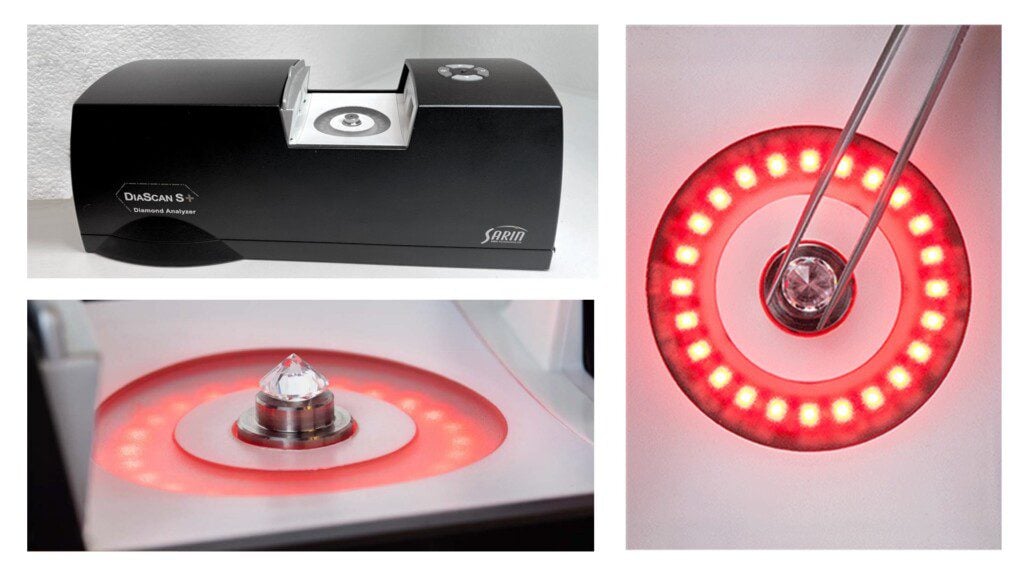
The 3D model is then imported into software designed to follow the light as it travels through the diamond, taking its total sculpture into account. This computer modeling approach is called “ray tracing.”
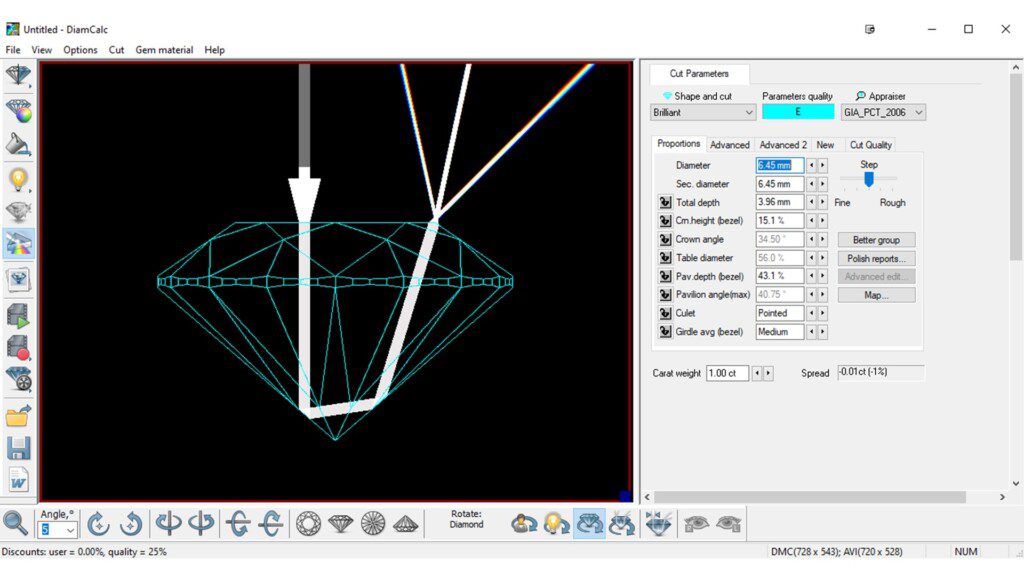
In 2005, the American Gem Society introduced a Light Performance Cut Grade system based on ray tracing. A diamond’s 3D scan is used to determine values for brightness, leakage, contrast, and dispersive potential. Those values determine the diamond’s performance grade on a scale of 0 (best) to 10 (worst). A computer generated image (CGI) of the diamond as it will be seen in the AGS ASET performance scope is also calculated and imprinted on AGS Platinum Reports.
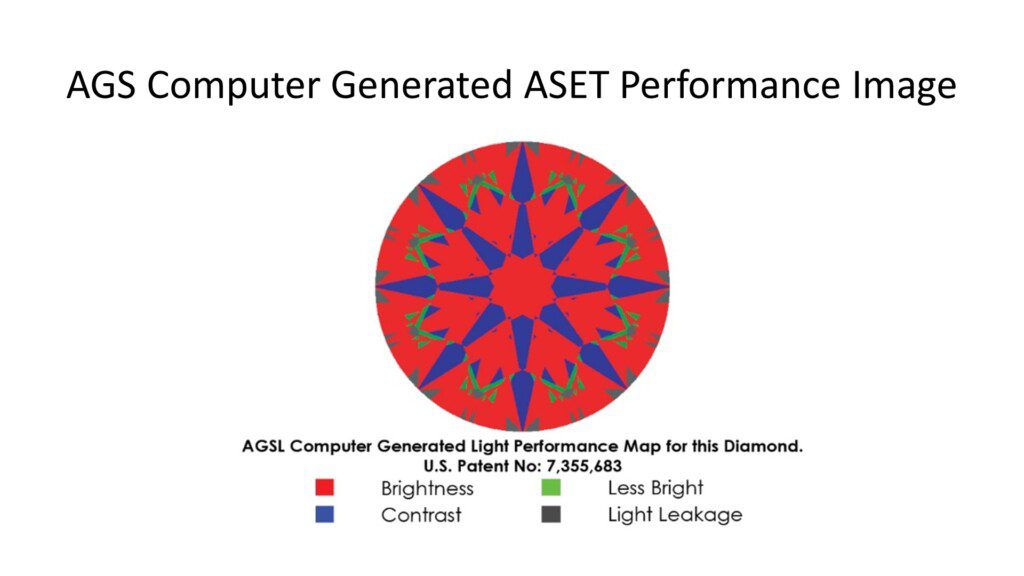
This is the world’s only diamond-specific cut grading system to date. In other words, only AGS analyzes each specific diamond sculpture in its entirety, tracing 40,000 rays of light with computer software. Other labs use a handful of average measurements, correlate them with charts, and pencil in a diamond cut grade.
Did you know? Every Super-Ideal diamond in the Whiteflash A Cut Above® collection is accompanied with an AGS Platinum Report proving scientifically measured Ideal light performance.
AGS offers “dual light map” and “triple light map” certificates, as seen below. In these cases, an ASET image is rendered for the bottom of the diamond. The only purpose of that rendering is to provide an impression of 3D optical precision, also known as “Hearts and Arrows.” While the 3D scan computer-generated images can be very representative, a diamond’s optical precision is best judged with actual photos or in-person viewing.
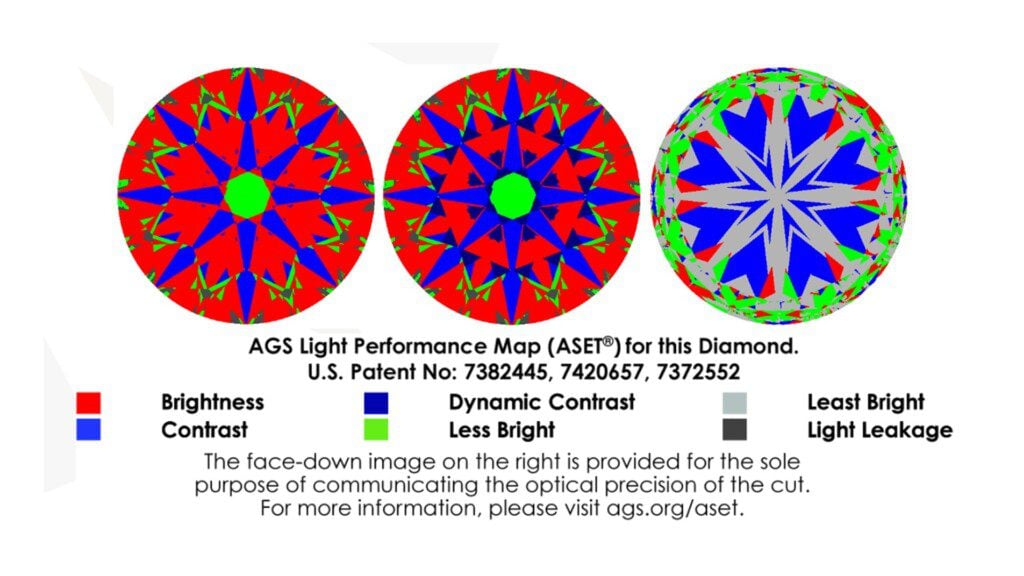
You can read more about optical precision on our Hearts and Arrows Diamonds page.
DiamCalc is a system for polished gemstone modeling and design. The software can be used to generate a variety of photorealistic diamond images and videos, including performance scope (i.e. Ideal Scope, ASET) and optical precision scope (i.e. Hearts and Arrows) simulations. Professional versions of DiamCalc feature a ray tracing engine which may be used to design theoretical diamonds, in the same manner as architects use CAD to design and assess buildings prior to construction.
PriceScope Pointer: Before using computer-generated images (CGI) for analysis it’s critical to know whether the images were generated by manual input or from a mechanical 3D scan of the diamond.
CGI can be produced in a variety of ways. How useful or accurate those images depends on whether they were generated from manual entry of facet-group averages, or generated from an actual mechanical scanner that measured the diamond in 3D.
Computer-generated images (CGI) can be produced by manually entering numbers from a grading report into the software. When this methodology is not disclosed it’s misleading. When broad average numbers are entered the software simulates perfect 3D optical precision for the missing facets (which don’t exist in nature) and produces images based on a theoretically perfect, unrealistic diamond wireframe.
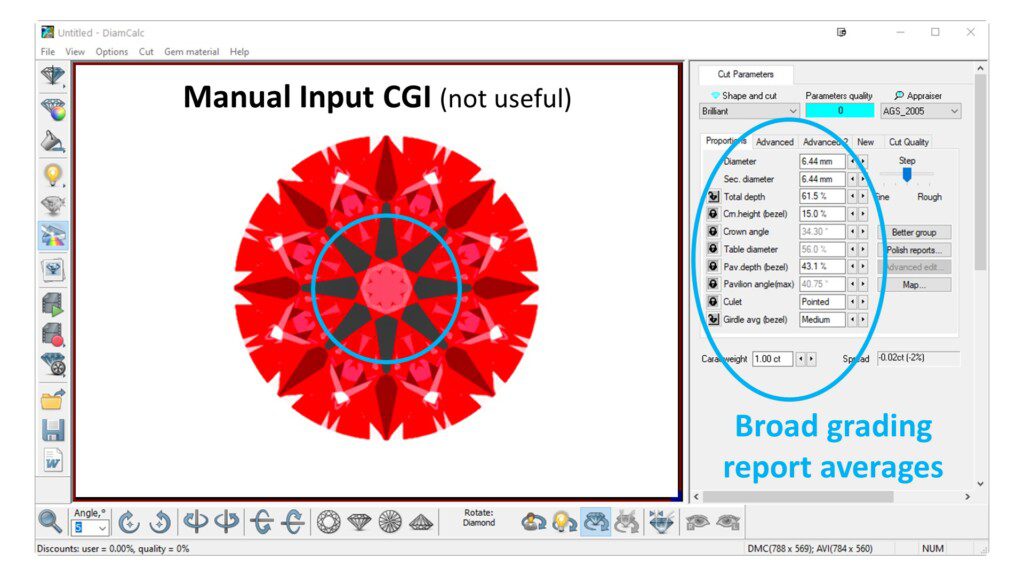
Note: Manual input of grading report averages can be useful for broad conclusions regarding overall light return versus light leakage. Such use should be clearly disclosed as a non-diamond-specific estimate.
Diamond 3D scans are useful for light performance assessment with ray tracing, as well as producing diamond-specific Ideal Scope and ASET CGI which are representative. Since all facets have been scanned in three dimensions the projections of light behavior within the diamond are accurate.
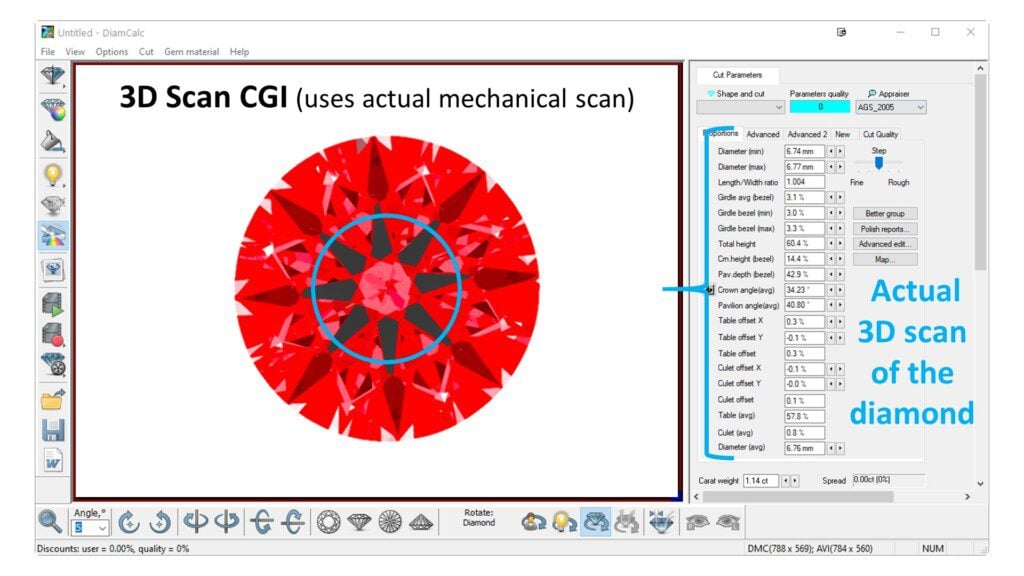
Hearts and Arrows Analysis: Hearts and arrows images generated with a 3D scan may be very close to the diamond’s actual hearts and arrows but are not as decisive as actual photos or in-person viewing. You can read more about optical precision on our Hearts and Arrows Diamonds page.
Because computer-generated images have the appearance of actual photos, it is important to verify with the seller if the imagery they are providing is actual photography of the diamond or CGI. If the images are CGI, verify that the seller secured a mechanical 3D scan of the actual diamond.
PriceScope Pointer: Whether intentional or by accident, some diamond sellers provide Ideal Scope, ASET, and Hearts and Arrows simulations from manual input CGI. Those images do not represent the subject diamond and give a false positive impression. Be sure a mechanical 3D scan was used. You might also ask the seller to send you the 3D scan. Common file formats are .SRN .STL .DMC .ASC and DXF./span.
Computer modeling is the most sophisticated method of clinical diamond cut assessment. When imported, 3D diamond scans can reliably and accurately be used to place diamond cut in a performance category such as GIA Excellent or AGS Ideal, and to identify shape subsets such as Super Ideal, PriceScope Ideal and Steep-Deep.
3D scans of gemstones are created without any contact. The diamond is placed on a rotary platform surrounded by lights. The lights turn on and the diamond’s silhouette is captured eight times as it rotates. An integrated camera measures the angles of that silhouette. Device makers acknowledge a potential linear error of ± 10 microns and angular error of ± 0.1 degrees per measurement.
With a high-quality 3D scan, much can be determined about overall diamond cut performance. For extremely nuanced analysis regarding matters like optical precision, or hearts and arrows, it’s best to use actual images or view the diamond in an optical precision scope in person.
Jewelry store spotlights are traditionally set up to make all diamonds appear bright and dynamic. This is much like a car dealer’s showroom, where the various automobiles are positioned and illuminated to best advantage. Like shopping for a car, judgment of a diamond’s performance should not be limited to the showroom, it’s best done when the item is removed from the sales-environment and “test-driven” through the environments it will normally see in everyday wear.

Diamonds are traditionally shown to buyers in a single location, typically under spotlights which make all diamonds look good. It’s important to remember that a diamond will look very different as it travels through the world’s infinite panoramas of illumination. Learn how to make thorough comparisons and discover what diamond speaks to you most through different scenarios.
If the three “Ls” of real estate are “Location, Location, Location”, the three “Ls” of cut are Lighting, Lighting, Lighting.

Start under overhead spotlights as you would see the diamonds in a jewelry store. Compare the diamonds at 18 inches. Hold them still, then move them slowly side to side. Then move them rapidly. Look for overall brightness (white and colored light). Ask which has more white sparkle (isolate glare), which has more colored sparkle, which seems more vivid (more intensity in brightness and darker contrast). Does one have more rapid/small sparkle while another has more broad/large sparkle?
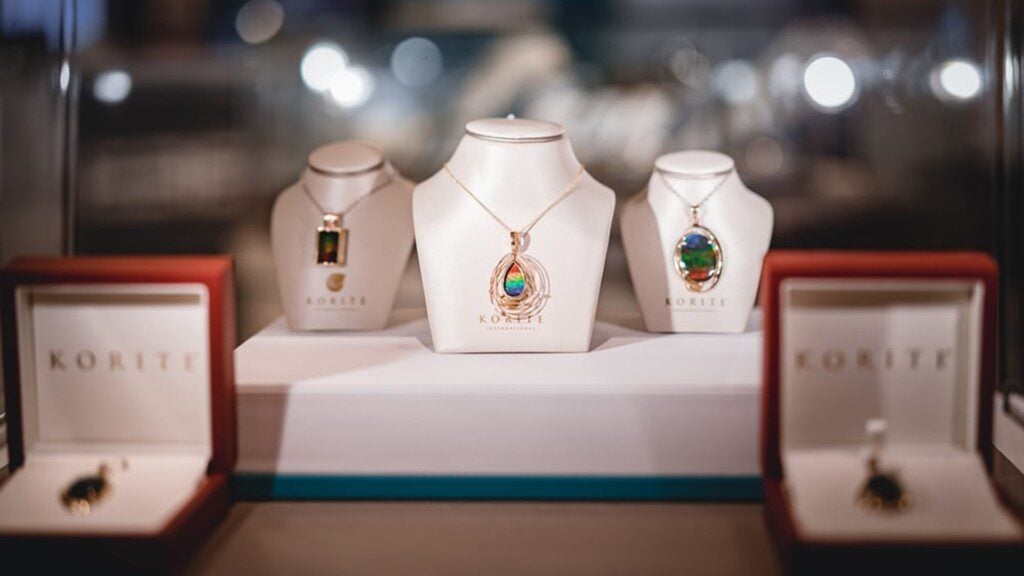
Now move them from arm’s length slowly to very close up. Does one get darker as it comes closer? Do they both remain as bright? Do they both remain as vivid in brightness and contrast? If you’re inclined to take notes, by all means, do, since these comparisons will be made in a few different lighting conditions.
Whether near a window or on a covered porch (not under direct sunlight), stand with daylight at your back so the diamonds are illuminated by natural outdoor lighting. Go through the same comparative exercises listed above. If it’s a cloudy day you can expect to see more brightness than fire. If it’s a sunny day the colored flashes should be vivid.

The sun is an incredibly bright light source but causes diamonds to look dark for two reasons. First, that diamond is ‘looking’ for light sources from horizon to horizon (180 degrees) but the environment has only one light source which occupies just 1/2 of a degree of sky. Second, bright sunlight causes the pupils of your eyes to constrict, or get smaller. So, while you see the (very) vivid sparkles that a single (very) bright source creates, the constriction of your pupils makes the surrounding areas effectively dark. If you walked into a jewelry store and killed all of the lights except the one you’d get the same result, only the diamond would be even darker, since no jeweler’s spotlight rivals the sun in intensity.
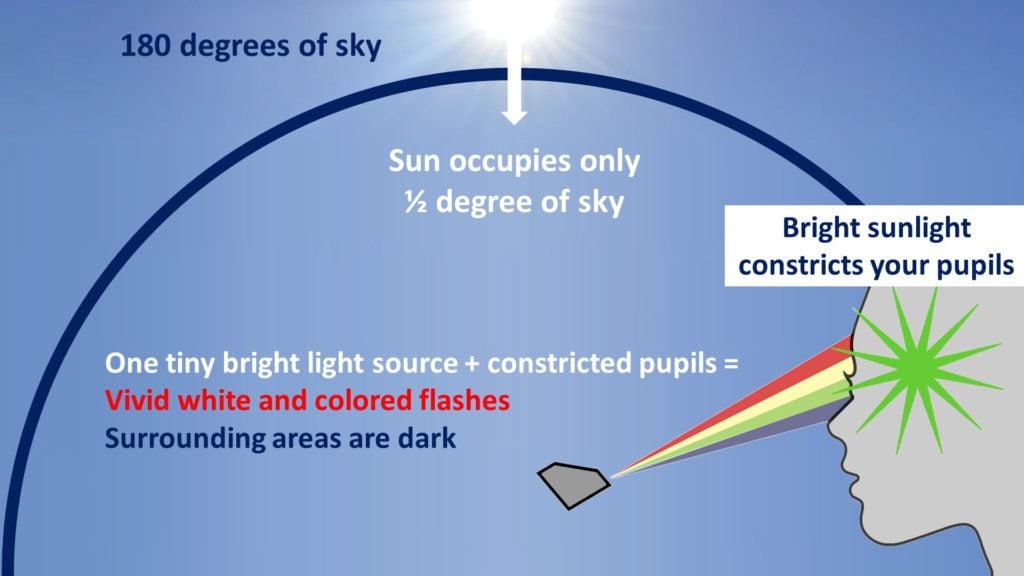
Learn why you see more colored flashes when your pupils constrict on our Diamond Fire and Dispersion page.
If you don’t have specific classroom or office-style lighting you can diffuse overhead lights with a pillowcase or sheet. There should be no spotlights or direct lighting of any kind in this environment. These conditions resemble the diffused northern daylight of a diamond bourse. Much like a cloudy day, you will see little or no fire here. Go through all of the same comparisons, this time focusing on how bright the comparative diamonds remain, and how symmetrical the contest patterns are.
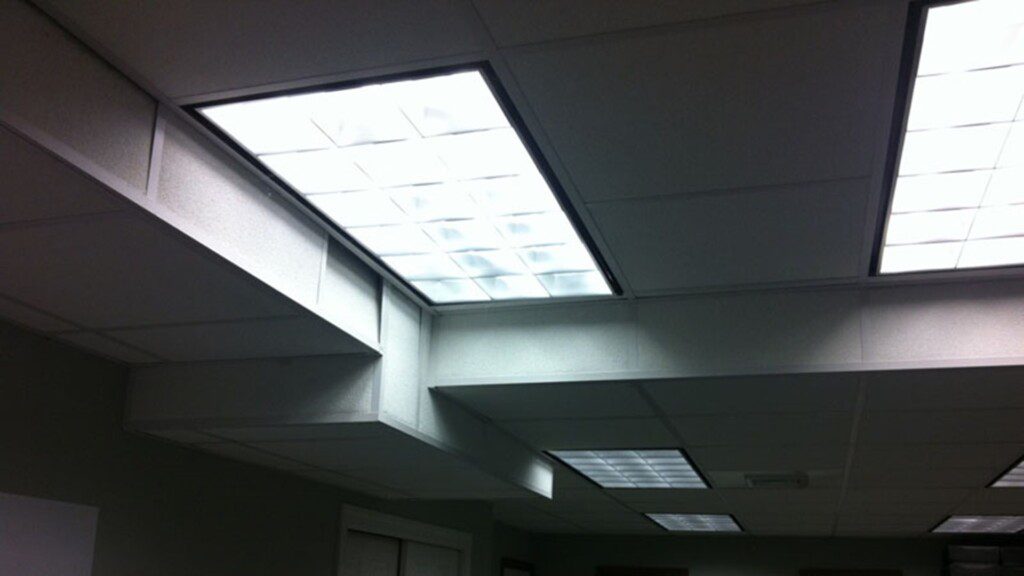
This can be done under your desk or kitchen counter. No direct light at all is preferred. In a pinch you can cup one hand over the other that is holding the diamond and see how it appears when gathering only the most limited light. A very important test in this condition is to see if either diamond “gets smaller” than the other, or if they both retain their side-to-side size appearance.
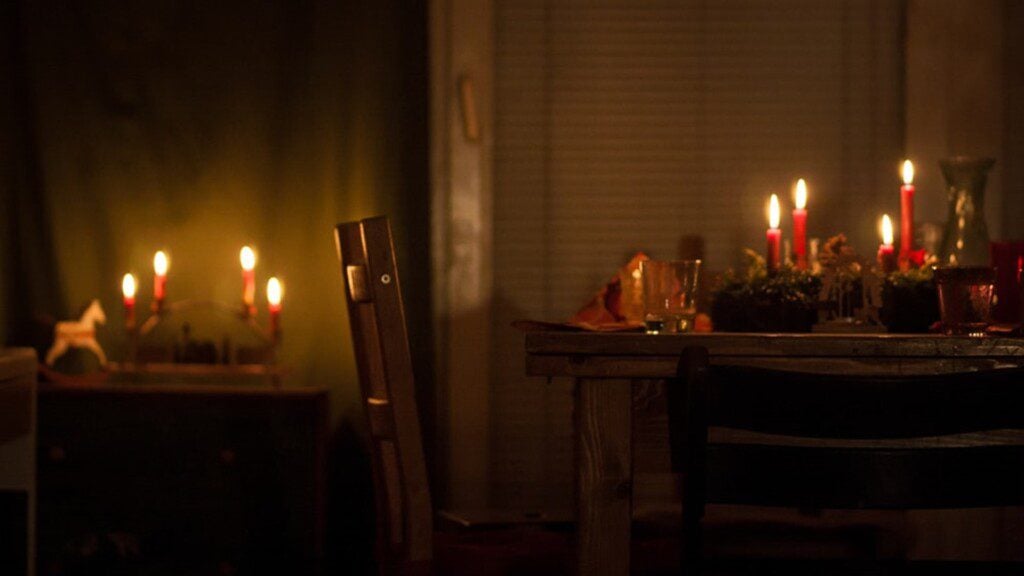
A diamond that seems to “get smaller” may not be returning light from edge-to-edge as the finest cut diamonds will – and one where you literally see through the center is leaking light through the pavilion.
Many diamond professionals have discovered the joy of viewing a well-cut diamond on a bright day, but standing underneath a tree where the leaves are moving and permitting sunlight to filter down to the diamond.

Why is this such a great environment? Ambient sunlight reaches down to the horizon, promoting edge-to-edge brightness, while the leaves break up the cascading sunlight, creating abundant scintillation events. Meanwhile, your pupils have contracted (because your brain registers the sunlight) and in that state they clip abundant dispersive fans, causing your optic nerve to perceive far more colored flashes than you do in other illumination scenarios.
It should go without saying but be sure the diamond is completely secure and will not fall or pop out of the tweezers if you choose to take it outside.
Get fast answers to any question: Ask our community of unbiased independent helpers.
People also ask
The round brilliant diamond is the most efficient shape for returning light to the viewer’s eyes, but only if it’s cut to PriceScope Ideal parameters. Unfortunately, the majority of diamonds are cut for weight at the expense of beauty despite earning the Excellent cut grade. GOOD NEWS. We can direct you to great cut using the PriceScope search. Read the PriceScope Diamond Buying Guide for no-miss instructions on finding well-cut diamonds.
Check out our Diamond Price Guide to see how different factors impact a 1 carat diamond’s price. We have also included a diamond price calculator for you to see today’s prices in real-time, based on more than 500,000 diamond listed in our search engine. Remember that the majority of diamonds are cut for weight at the expense of beauty. So the diamonds at the more expensive end of our average prices are likely to have been cut for better beauty and less weight.
Leakage is a negative diamond performance component, where light passes through the bottom of the diamond instead of reflecting back to the viewer’s eyes. Read about leakage, as well as the positive diamond performance components on our page Diamond Performance Explained.
Get More Knowledge

Retail Diamond Prices Chart Updated Monthly.

Two Paths, One Diamond Not all diamonds come from the same place — but they all start the same way. Pure carbon, crystalized under immense pressure and heat. Whether it…
A Wedding Ring as Unique as Your Love Finding the right wedding ring isn’t just about diamonds or gold – it’s about finding the one that feels right. With hundreds…
So, you’re thinking about lab-grown diamonds? Smart move. They’re just as sparkly as the natural kind but usually cost less. But where do you actually go to buy them? It…

Want to stay updated on the most recent blogs, forum posts, and educational articles? Sign up for Bling News, PriceScope’s weekly newsletter.